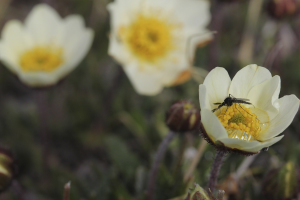Insect pollination is as important to ArcticDefinitions of the Arctic vary according to environmental, geographical, political, cultural and scientific perspectives. Some scientists define the Arctic as areas having a high latitude, long winters, short, cool summers,... More plants as it is to plants further south. When flowers abound, the plants have to compete for pollinators. Researchers at the University of Helsinki reveal that higher temperatures cause the flowering periods of different plant species to pile up in time. As a consequence, climate changeAccording to the United Nations Framework Convention on Climate Change, climate change is change in the climate of the whole Earth or a region of the Earth that is believed... More may affect the competitive relationships of plants.
The most attractive plant species steal the majority of pollinators, making other plants flowering at the same time suffer from poorer pollination.
“Most flowering plants are dependent on the pollination services provided by insects. Thus, plants need to time their flowering to periods of maximal pollinator abundances. On the other hand, plant species compete with each other for pollination. Thus, plant species flowering at the same time can affect each other’s pollination success. Temperature is one of the most important environmental determinants of the onset of flowering. As the climateThe average weather we would expect over a long period of time (seasons, years, decades). Climate varies from place-to-place across the Earth. Climate is determined by long-term (over at least... More warms, plant species change their flowering periods, thereby changing their competition for pollinators”, explains Mikko Tiusanen, researcher at the Faculty of Agriculture and Forestry, University of Helsinki, and lead scientist behind the study.
The research group was supported by INTERACT Trans-National Access.
Read more at the University of Helsinki website.

